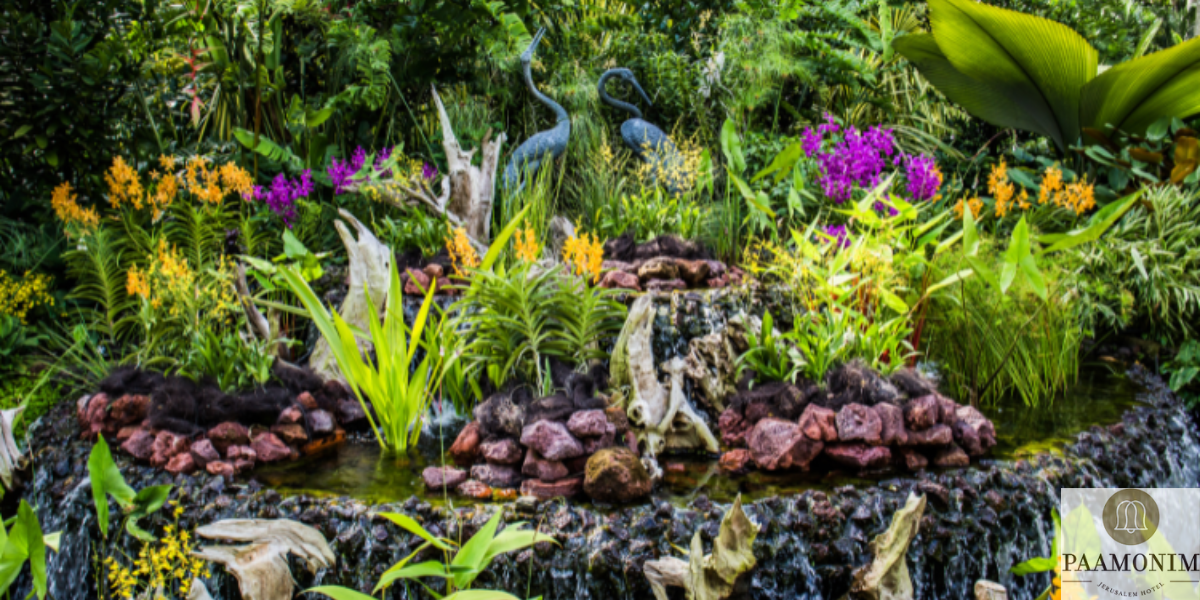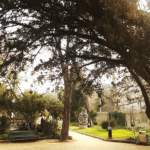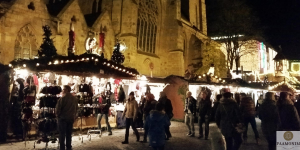
The Paamonim Hotel Jerusalem allows visitors to experience Jerusalem beyond accommodation since we want them to deeply connect with Jerusalem’s cultural heritage and natural and historical elements in the Holy City. Those who visit Jerusalem typically seek out historic landmarks and spiritual sites, yet the city features peaceful, secluded destinations that provide urban relief. The Jerusalem Botanical Gardens represents a wonderful hidden attraction set among diverse flora only a few kilometres from our hotel.
Visitors can explore an abundance of 6,000 plant species spread across 30 acres of the vast botanical park, which provides a journey through global biodiversity. All visitors, including nature fans, pho, photographers, families seeking an active outing, and people who love landscaped gardens, will discover exceptional botanical delights at this site. During your time at Paamonim Hotel Jerusalem, you should reserve a visit to the Jerusalem Botanical Gardens, which we have analyzed as we analyze all the essential features this attraction provides.
A Green Paradise in the Heart of Jerusalem
The Jerusalem Botanical Gardens is located in the Naot neighbourhood of Jerusalem, where visitors often recognize it as a well-hidden urban treasure. The garden’s peaceful natural beauty stands opposite the busy Jerusalem streetscape. Visitors seeking serenity can find it at the botanical gardens, which offer peaceful solace unlike the famous religious landmarks or historical sites in Jerusalem.
Attraction stems from the garden’s deliberate layout, which turns the park into various themed sections displaying plants from unique regions. Through this botanical path, visitors can travel to multiple parts of the world, featuring plants from Africa, Asia, Australia, Europe, and the Mediterranean region. Visitors experience a living museum within the beautiful garden because different plant zones display distinct stories through their growing species.
The garden atmosphere becomes serene due to leaf rustling sounds and bird songs alongside the flowing water of their lakes and ponds. The Jerusalem Botanical Gardens provide visitors an opportunity to unwind from their daily lives through its peaceful environment while also allowing exploration into different ecosystems. The garden offers the chance to reconnect with nature while allowing visitors to experience various plants through one remarkable setting.
History and Significance of the Jerusalem Botanical Gardens
The Jerusalem Botanical Gardens maintains its appeal through a rich history spanning almost a century. The garden emerged in the 1930s under the Hebrew University of Jerusalem, operating as an academic research location dedicated to studying local plant species. The establishment began with the dual purpose of delivering a Middle Eastern flora learning space for students and developing plant biology research.
After the 1948 Arab-Israeli War, access to the original site where the garden had existed was limited to Mount Scopus. After World War II, a relocation to Nayot became necessary, and this move set the foundation for what would become the grand botanical garden of modern times. Over time, the garden evolved from serving as a research centre to building a status as an internationally celebrated institution focusing on plant conservation and sustainability education.
Through its current location at Nayot, the Jerusalem Botanical Gardens actively contributes to protecting endangered plants from both domestic and foreign species. This facility operates within a worldwide system of laboratories that work to preserve plant diversity and study plant functions for sustaining ecosystem equilibrium. The gardens constantly collaborate with global institutions to support their efforts in conserving rare and endangered species. The gardens provide environmental education through comprehensive programs while actively teaching people about the importance of plants and sustainability in ecology.
Exploring the Gardens: A Journey Across Continents
The Jerusalem Botanical Gardens presents a unique design that enables visitors to tour ecologic ranges worldwide from a single Jerusalem location. The botanical garden is organized in multiple sections, which present native plants from around the world’s different geographical regions. A journey through the various zones at the Botanical Gardens lets visitors discover African savannahs and Asian rainforests before reaching the hills of the Mediterranean and finally reaching the vast Australian terrain. The garden staff curates each part precisely, providing visitors with knowledge about regional plant species and the aesthetically pleasing landscape design.
The Mediterranean Section: A Celebration of Native Flora
The Mediterranean garden section presents an intriguing display of regional native plants in Jerusalem and surrounding areas. The Mediterranean climate region includes Jerusalem, which features the Mediterranean section of the garden, which displays various native plants from this region. People visiting this area will find numerous plants, including enduring olive trees and traditional wild herbs, including rosemary, thyme, and lavender. These herbs serve essential purposes in Israeli cultural meals and natural medicine. The Mediterranean portion hosts numerous wild plants that come alive during springtime to paint the gardens with vibrant flowers. During your walk through this garden section, you will see natural aspects of the land which developed the cultural identity and dietary traditions along with the historical heritage of the surrounding area.
The Australian Section: Eucalyptus Forests and Exotic Shrubs
Visitors who walk through the Australian section get to tour landscapes which differ strongly from Jerusalem’s Mediterranean hills. You enter the section which adopts the forestal atmosphere of Australian wilderness with large standing eucalyptus trees that shape a cooling covering of shade. The aromatic oil-producing trees which symbolize Australia create a timeless representation of the nation’s natural environment. The Australia section contains both eucalyptus trees and native acacia trees, together with other exclusive shrubs and plants that exclusively thrive in Australia. The section provides a peaceful atmosphere by combining the majestic trees with a cooling breeze and relaxing natural noises.
The African Section: Surviving in Extreme Climates
The African section of the botanical gardens Jerusalem provides a distinct experience showing how certain plants succeed in Earth’s most intense environmental zones. Attractions at this part include the imposing baobab tree with its water-storing trunk and its notable massive trunk form. The succulent and cacti collection presents species that have developed survival strategies for Africa’s arid savannas and desert areas. Nature has proven its ability to adapt for survival through the African section, allowing visitors to recognize the resilient plants that evolved to survive harsh droughts and extreme heat.
The Asian Section: Cherry Blossoms and Bamboo Forests
The Asian section of the garden creates an experience reminiscent of a peaceful, traditional Asian natural setting. This botanical garden Jerusalem section at Mount Auburn executes an unparalleled demonstration of Japanese cherry blossoms with their magnificent pink and white blooms that happen yearly during springtime. A part of the Asian section incorporates bamboo forests that move peacefully with the wind, creating peaceful and meditation-like surroundings. Visitors can study many antique Chinese medicinal plants which traditional medicine practitioners have used for centuries. The Asian section of the garden allows visitors to both study Eastern botanical traditions and experience the peaceful natural beauty of essential traditional Asian plants.
The European Section: A Seasonal Showcase
The European section displays European plant species that flourish best in cold environments. In this area, you can see oak trees that symbolize durability and tulips with their spectacular springtime display of colour. Many European section plants become inactive throughout the fall and winter until spring when they display their colourful blossoms and leafy growth. A series of lavender fields spread across this section generates pleasant scents that envelop the atmosphere. Visitors can observe plant adaptations to various climate zones throughout Europe at the beautiful European section of the garden.
Family-Friendly Attractions and Activities
The Jerusalem Botanical Gardens serves various types of visitors because it welcomes serious plant enthusiasts and families who love spending time with their children. The garden features numerous enjoyable educational activities which appeal to visitors of every age group.
Children love the Enchanted Trail because it provides a magical journey that follows a storybook theme among the gardens’ paths. The trail includes interactive installations and hidden surprises, which promote kid exploration while nurturing their imagination of the natural environment. It also provides an educational experience with interactive learning opportunities that teach kids about plants while offering enjoyable educational experiences.
The botanical garden offers visitors the option to relax on a mini train that conducts guided journeys through the important parts of the garden. The mini-train tour is an excellent opportunity for children, elderly visitors, and anyone desiring a relaxed visit throughout the gardens without extensive distance walking.
The garden promotes seasonal workshops and educational programs for visitors to discover. It offers sustainable gardening workshops and arrangement classes, which teach guests different methods of designing decorative floral displays. Through its educational initiatives, the garden provides programs that help guests gain profound respect for nature while learning about biodiversity protection and environmental sustainability.
Why Stay at Paamonim Hotel Jerusalem When Visiting the Botanical Gardens?
Staying at Paamonim Hotel Jerusalem puts you perfectly close to visiting the Botanical Gardens Jerusalem and all major sites in the city. Our hotel benefits from a strategic location in the central part of Jerusalem, where guests can easily reach major city attractions, including the botanical gardens.
The hotel provides guests with comfortable rooms with contemporary amenities, and they can enjoy panoramic views across the city limits. The hotel staff provides friendly assistance with recommendations, transportation, and tour bookings to help you maximize your visit experience. Our hotel serves a delicious Israeli breakfast to provide you with the necessary energy before you start discovering new places.
Conclusion:
The Jerusalem Botanical Gardens is a peaceful and captivating attraction within the city that combines natural beauty with cultural value and educational programs. This botanical paradise invites every visitor to experience its charm regardless of their age or interests so they can discover the bed of blossoming flowers.
The proximity of Paamonim Hotel Jerusalem to this magical location ensures that all visits to Jerusalem Botanical Gardens are convenient and memorable for our guests. Experience the best of Jerusalem by booking your stay at our hotel, and discover the perfect mix of city life and natural charm.




